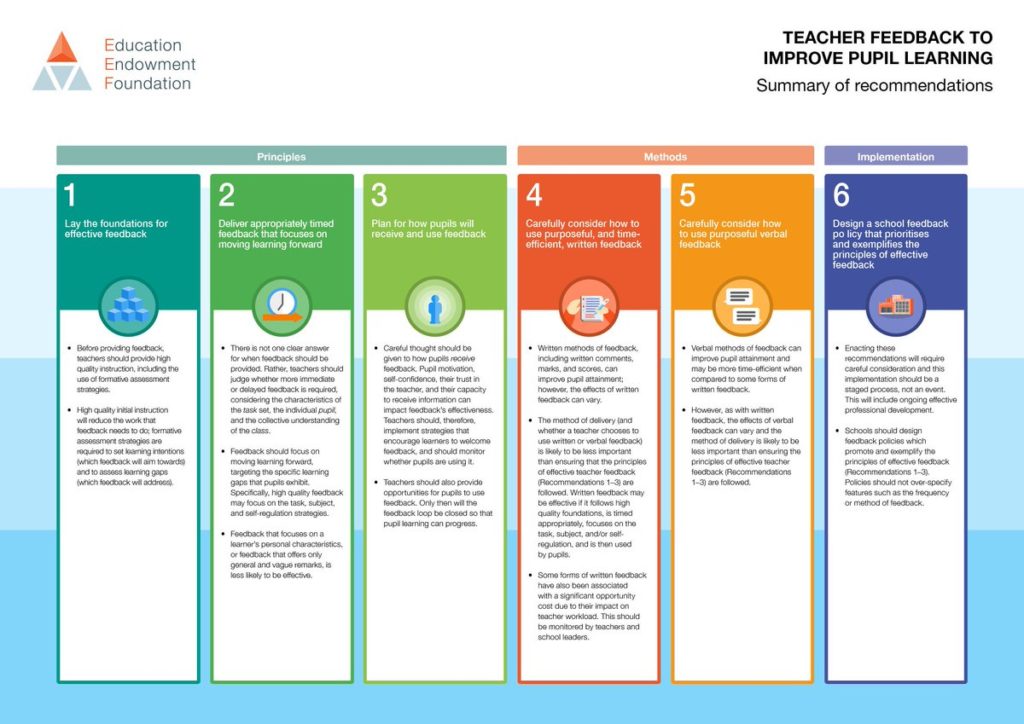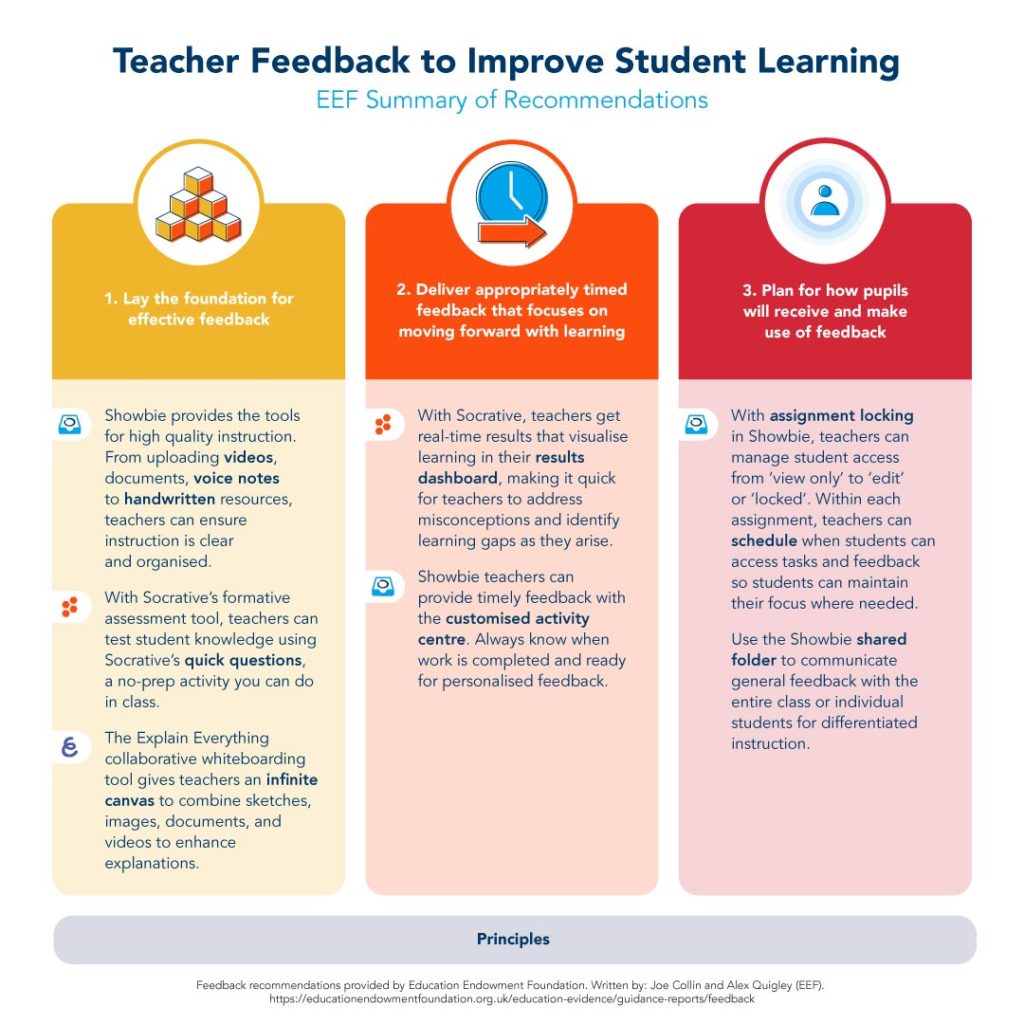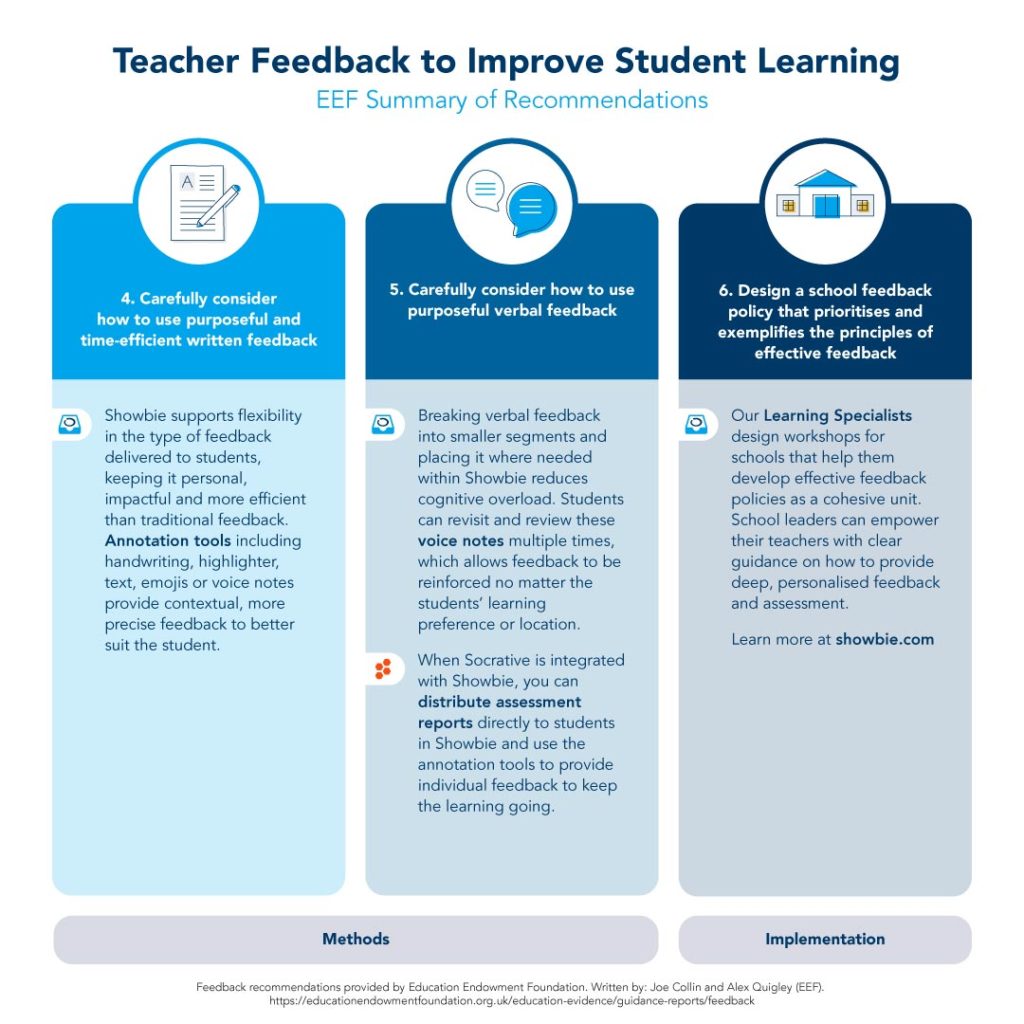What exactly is the EEF?
The Education Endowment Foundation is a research-led organisation based at the University of Oxford that provides school leaders and teachers with recommendations on how to enrich learning experiences. In June 2021, the EEF published an insightful report entitled, ‘Feedback in action: A review of practice in English schools.’
The study analysed feedback policies – looking at their purpose, workload and strategies. It found that no two policy approaches were the same and that schools are constructing their feedback policies based on individual teaching and learning strategies. Here are some of the highlights we found interesting from the study:
Inconsistent Feedback Policy Negatively Impacts Teachers.
One finding from the study was that many policies did not reference any evidence-led research, likely due to their heavy publication. The foundation suggests that referencing publicly available policy reviews can help anchor practice in the classroom while boosting academic credibility. The EEF also uncovered that a lack of feedback policy in primary schools could negatively impact teacher workload.
The Definition of ‘Good Feedback’ and Importance of Verbal Feedback
The survey asked primary teachers across England what constitutes good feedback? The top four responses were:
- Instant/Live feedback
- Verbal feedback
- The feedback that moves learning forward
- Personalised feedback
Both teachers and school leaders align on the importance of verbal feedback. The EEF report showed that school leaders recognise the importance of verbal feedback and that a dialogue between pupils and teachers is essential to its reception.
The survey also showed that teachers felt feedback should focus on the following three areas:
- Helping to improve future performance
- Assisting to enhance the current piece of work, or;
- To improve how a student approaches their tasks.
Written feedback: Lots of Work for Low Impact
While written feedback used to be the favoured method, the report highlights that there’s been a decline in the delivery of written feedback – and that schools are revising their policies in an attempt to reduce the associated teacher workload.
Many teachers are still finding written marking to be a significant issue for their workload, as per the TALIS 2018 findings where 65% of secondary teachers and 58% of primary teachers thought that there was ‘too much’ or ‘far too much’ marking required.
The timeliness and frequency of written feedback were also explored. Interestingly, in primary schools, 66% of teachers aim to give written feedback within 24 hours. That timely feedback is provided 2-3 times per week by 38% of primary teachers surveyed, and over a third of them are giving written feedback every day.
The timeliness of feedback delivery changes when looking at the responses from secondary teachers – they take longer to provide written feedback, with 47% indicating they provide feedback within one week of work submission. Secondary teacher feedback tends to be more detailed, so it’s provided less often, with some presenting it every fortnight (42%) or only once per half term (35%). Notably, there is a marked drop-off in secondary students acknowledging written feedback – 49% of respondents stated that students have moved on in their learning by the time feedback is shared and reviewed. As a result, that piece of work is no longer top of mind, leading to a lack of motivation (69%).
EEF’s Six Recommendations for Feedback
The EEF has six recommendations for teacher feedback, based on researched principles and methodology:
- Lay the foundation for effective feedback
- Deliver appropriately timed feedback that focuses on moving forward with learning
- Plan for how pupils will receive and make use of feedback
- Carefully consider how to use purposeful and time-efficient written feedback
- Carefully consider how to use purposeful verbal feedback
- Design a school feedback policy that prioritises and exemplifies the principles of effective feedback
Better Feedback with Showbie & Socrative
Showbie, the hybrid learning platform, works with Socrative, the classroom tool for formative and summative assessments, to support teachers who want to implement these guidelines and put evidence-led strategies into practice.
Set Up for Success – Lay the Foundation for Effective & Timely Feedback (#1, #2 & #3)
The report identifies that before providing feedback to students, teachers should concentrate on delivering high-quality instruction before giving feedback to students, including formative assessment, in order to lay the foundations for effective feedback.
Showbie provides the tools for high-quality instruction from uploading videos, documents, voice notes to handwritten resources so teachers can ensure instructions are clear and organised. Students always know exactly where to find their assignments, review instructions, and revisit those instructions when needed. The ability to upload any file type means teachers can provide students with varied, purposeful, engaging content and assignments – including augmented reality and more.
The EEF suggests using formative assessment to set learning intentions and assess learning gaps to help inform teacher feedback. With our formative assessment tool, Socrative, teachers can test student knowledge during (or at the end of) a lesson, using Socrative’s Quick Questions, a no-prep activity you can do in class.
To enhance explanations and feedback, the Explain Everything collaborative whiteboarding tool provides teachers and students with an infinite canvas for visual learning with a variety of media. Sketches, images, documents and videos combine to create engaging lessons for your students while enabling them to demonstrate their learning in creative ways from anywhere.
When it comes to appropriately timed feedback that focuses on moving forward with learning, teachers using Socrative get real-time results that visualise learning in their Results Dashboard, making it quick for teachers to address misconceptions and identify learning gaps as they arise. This allows teachers to provide students with timely, meaningful notes or content before the lesson moves on. In Showbie, teachers can provide timely feedback with the Customised Activity Centre so they always know when work is completed and ready for personalised feedback.
When planning for how pupils will receive and make use of feedback, Showbie can help manage the workflow. With Assignment Locking, teachers can manage student access from ‘view only’ to ‘edit’ or ‘locked’. Within each assignment, teachers can schedule when students can access tasks and feedback so students can maintain their focus where needed. Then, use the Showbie Shared Folders to communicate general feedback with the entire class or individual students for differentiated instruction.
Using Technology for Effective Written & Verbal Feedback (#4 & #5)
As noted, there is no singular way to deliver effective feedback; Teachers deliver and tailor feedback in many forms. The EEF recommends that educators carefully consider how to use purposeful and time-efficient written feedback, as well as purposeful verbal feedback.
With Showbie, you have flexibility in the type of feedback you’d like to deliver to each student, keeping it personal, impactful, and more efficient than traditional feedback. Showbie’s feedback Annotation Tools include handwriting, text, highlighter, emojis or detailed voice notes (up to 30 minutes long), that can be placed anywhere on a document, to provide contextual, more precise feedback to better suit the student.
As it can increase a teacher’s workload, the EEF recommends that the quantity of written feedback be monitored. Showbie’s annotation tools help with this by opening up new pedagogies for the feedback loop. As an alternative to providing written feedback in exercise books, students can scan and upload handwritten pages into Showbie, where teachers then annotate and deliver feedback much more efficiently than handwritten feedback. This also helps reduce fatigue when writing, so students can continue to be prepared for handwritten exams.
Showbie’s voice note annotations are also a great way to provide purposeful verbal feedback. Detailed, personalised feedback helps move learning forward while simultaneously improving (and even reducing) teachers’ workload. Breaking verbal feedback into smaller segments and placing it where needed on student work offers the opportunity to reduce cognitive overload. Students can revisit and review these voice notes multiple times, from anywhere, which allows the feedback to be reinforced, no matter the students’ learning habits or location.
The report mentions that verbal feedback is “further valued because of its connection to the personal relationship between student and teacher, which is considered to be important as a factor in feedback.” Many teachers have shared that Showbie’s voice notes help facilitate more robust connections between them and their students, a critical part of effective feedback that isn’t often discussed.
When Socrative is integrated with Showbie, teachers save time and improve workload with automated marking. They can then distribute assessment reports to students in real-time that can be verbally annotated to enrich individual feedback and narrow any knowledge gaps.
Instill Better Feedback, School-Wide (#6)
At Showbie, our Learning Specialists design workshops for schools that help them develop effective feedback policies as a cohesive unit. At the end of these workshops, school leaders can empower their teachers with clear guidance on how to provide deep, personalised feedback and assessment.
If you’re looking to implement more effective feedback policies at your school, send us a message – we’d be happy to help!
Resources
Download Showbie and Socrative PDF Summary of EEF Recommendations
Download Effective Feedback Policy Sample






